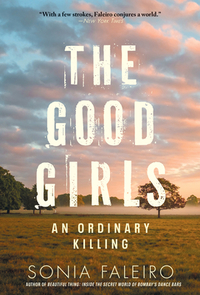Take a photo of a barcode or cover
challenging
dark
emotional
mysterious
sad
slow-paced
challenging
dark
sad
tense
medium-paced
challenging
dark
medium-paced
Important story but hard to read in terms of the presentation of the narrative and style. The story felt chaotic which is probably an accurate reflection of how the deaths of the girls were investigated. Assumptions we make in UK about justice, public authorities, and the social mores that govern personal life are so out of touch with the reality of these families - poor, rural, low caste. The most illuminating chapter was the author’s reflections - start with that and the read will be more accessible
challenging
dark
emotional
informative
reflective
sad
tense
slow-paced
challenging
dark
sad
medium-paced
This retelling of the death of 2 girls in rural India was at times equally heartbreaking, blood-boiling, and frustrating because of the subject matter. The author very skillfully weaves in India's numerous social mores that directly impacted how these deaths were investigated. Specifically, religion, poverty, caste, education, gender, and India's own racism are each spotlighted over the course of the book and the threads play out as the story progresses. I was impressed as to how the author, for the most part, was very clinical in her assessment of these factors. That being said, there were times where her own feelings crept in - appropriately so.
Sadly, what stuck with me the most was the author's statement towards the end of the book, paraphrased as 'at the end, everyone went back to their lives as if nothing had happened'. The power of that sentiment resonated so well because the author had built up all the factors noted above and those factors led to the minimization of the deaths of the girls.
Sadly, what stuck with me the most was the author's statement towards the end of the book, paraphrased as 'at the end, everyone went back to their lives as if nothing had happened'. The power of that sentiment resonated so well because the author had built up all the factors noted above and those factors led to the minimization of the deaths of the girls.
[Disclaimer: e-ARC received from NetGalley in exchange for an honest review. All opinions are my own.]
This was a really interesting look at a crime from an area of the world I don't know enough about. It was sad how parts of the story seemed so crazily third world for a crime committed in 2014 and how if the media hadn't gotten involved in the case almost no investigating would have been done at all.
The story did get a little bogged down in stats and, as a result, got quite dry at times.
This was a really interesting look at a crime from an area of the world I don't know enough about. It was sad how parts of the story seemed so crazily third world for a crime committed in 2014 and how if the media hadn't gotten involved in the case almost no investigating would have been done at all.
The story did get a little bogged down in stats and, as a result, got quite dry at times.
informative
fast-paced
Bon bon bon. Pour tout vous dire, j'ai commencé ce livre le 29 avril - autant dire que, me concernant, ce n'est pas très bon signe.
Bien que l'histoire m'ait intéressée, j'ai eu du mal à rentrer dedans. D'une part, c'est la reconstitution par une journaliste d'un fait divers, et les personnages sont donc réels et très très nombreux. D'autre part, j'ai trouvé que la frontière entre récit/documentaire était assez floue : durant la première partie, on a vraiment l'impression de lire un roman. Par la suite, la reconstitution est beaucoup plus documentée. En fin d'ouvrage, l'autrice explique sa démarche, son mode de fonctionnement, et le temps (4 années !) que lui a pris cette enquête. Peut-être aurait-il été plus judicieux de le faire au début ?
Je suis déçue car la thématique des violences faites aux femmes (en Inde, ou ailleurs) me tient énormément à cœur et me révolte. Je ne peux nier que j'ai beaucoup appris, par cette lecture, sur les fonctionnements de la société indienne : corruption, honneur de la famille, conditions de pauvreté dans certains états...
Il est très très rare que j'abandonne un livre en cours de route, car j'ai toujours une sensation d'échec. Je l'aurais sûrement fait cette fois-ci si je m'étais écoutée...
Bien que l'histoire m'ait intéressée, j'ai eu du mal à rentrer dedans. D'une part, c'est la reconstitution par une journaliste d'un fait divers, et les personnages sont donc réels et très très nombreux. D'autre part, j'ai trouvé que la frontière entre récit/documentaire était assez floue : durant la première partie, on a vraiment l'impression de lire un roman. Par la suite, la reconstitution est beaucoup plus documentée. En fin d'ouvrage, l'autrice explique sa démarche, son mode de fonctionnement, et le temps (4 années !) que lui a pris cette enquête. Peut-être aurait-il été plus judicieux de le faire au début ?
Je suis déçue car la thématique des violences faites aux femmes (en Inde, ou ailleurs) me tient énormément à cœur et me révolte. Je ne peux nier que j'ai beaucoup appris, par cette lecture, sur les fonctionnements de la société indienne : corruption, honneur de la famille, conditions de pauvreté dans certains états...
Il est très très rare que j'abandonne un livre en cours de route, car j'ai toujours une sensation d'échec. Je l'aurais sûrement fait cette fois-ci si je m'étais écoutée...
This was a really great investigative piece of work that researched the case of two village girls in India who were tragically found hanging from a tree. The family purposefully kept them hanging for an extended amount of time in order to attract the attention of the politicians and media. In doing so, they wanted to shed light on caste politics, the rights (or lack thereof) of poor farmers and corruption in the police force and government but in reality, this case unintentionally brought upon SO many additional major issues like the unjust obsession to preserve a female’s honor (and the lengths villagers take to ensure this honor) and the rights (or again, lack thereof) of village women.
In trying to find the supposed murderers for this case, there were so many flaws and mistakes from the get go. I’m surprised the author was able to keep up with all the conflicting evidence, the major players in the story and the convoluted facts. Despite all this, she was able to come up with a pretty cohesive timeline for the reader. However, you have to REALLY pay attention to keep up. In saying all of this, this isn’t for the weak. In trying to piece together the death of these two teen girls, the author discusses landmark rape and murder cases in between to give us the bigger picture of what is happening. There is so much tragedy and sorrow - it’s at times, unbearable to take in. Just thinking about the girls having to hang there for an extended amount of time just to prove a point is beyond heartbreaking for them - a simple dignity they were denied and for what? It’s also infuriating to read about the disparity between the poor and rich (even more so, between the politician/public servant and their constituents they purport to serve).
I often hate how India gets perceived by Westerners who like to take the moral high ground when discussing how “dirty, corrupt and poor” the country is while their own country faces multiple issues. I always want to defend it because there’s always more to a story and even more so, no country is ever perfect. However, this book was so well done that there is no denying the problems India faces. She states facts and figures and evidence that is well-corroborated. She is as objective as one can be. I found myself unable to overcome my despair for the country. There is such a deep level systemic problem in India that it feels impossible that anything could ever get fixed. My heart goes out to those poor girls where getting raped is more honorable to the men of the village than having pre-marital relations with a man. That their worth is only calculated by their marriageable potential. That higher education is nearly unattainable and basic essential needs such as toilets are inaccessible and therefore, their life is restrictive to the home, always. That all of this is compacted by caste and corruption issues that plague the agencies that are supposed to protect them (the police, the ministers, their own fathers)
While this case was mishandled so epically, I hope this book can at least spark some outrage and policy change the way the Delhi bus rape did. But writing laws for these atrocities isn’t enough and finding solutions seem impossible. This book just makes you even more depressed at the state of the world and the hopelessness we face when such tragic events occur.
In trying to find the supposed murderers for this case, there were so many flaws and mistakes from the get go. I’m surprised the author was able to keep up with all the conflicting evidence, the major players in the story and the convoluted facts. Despite all this, she was able to come up with a pretty cohesive timeline for the reader. However, you have to REALLY pay attention to keep up. In saying all of this, this isn’t for the weak. In trying to piece together the death of these two teen girls, the author discusses landmark rape and murder cases in between to give us the bigger picture of what is happening. There is so much tragedy and sorrow - it’s at times, unbearable to take in. Just thinking about the girls having to hang there for an extended amount of time just to prove a point is beyond heartbreaking for them - a simple dignity they were denied and for what? It’s also infuriating to read about the disparity between the poor and rich (even more so, between the politician/public servant and their constituents they purport to serve).
I often hate how India gets perceived by Westerners who like to take the moral high ground when discussing how “dirty, corrupt and poor” the country is while their own country faces multiple issues. I always want to defend it because there’s always more to a story and even more so, no country is ever perfect. However, this book was so well done that there is no denying the problems India faces. She states facts and figures and evidence that is well-corroborated. She is as objective as one can be. I found myself unable to overcome my despair for the country. There is such a deep level systemic problem in India that it feels impossible that anything could ever get fixed. My heart goes out to those poor girls where getting raped is more honorable to the men of the village than having pre-marital relations with a man. That their worth is only calculated by their marriageable potential. That higher education is nearly unattainable and basic essential needs such as toilets are inaccessible and therefore, their life is restrictive to the home, always. That all of this is compacted by caste and corruption issues that plague the agencies that are supposed to protect them (the police, the ministers, their own fathers)
While this case was mishandled so epically, I hope this book can at least spark some outrage and policy change the way the Delhi bus rape did. But writing laws for these atrocities isn’t enough and finding solutions seem impossible. This book just makes you even more depressed at the state of the world and the hopelessness we face when such tragic events occur.



